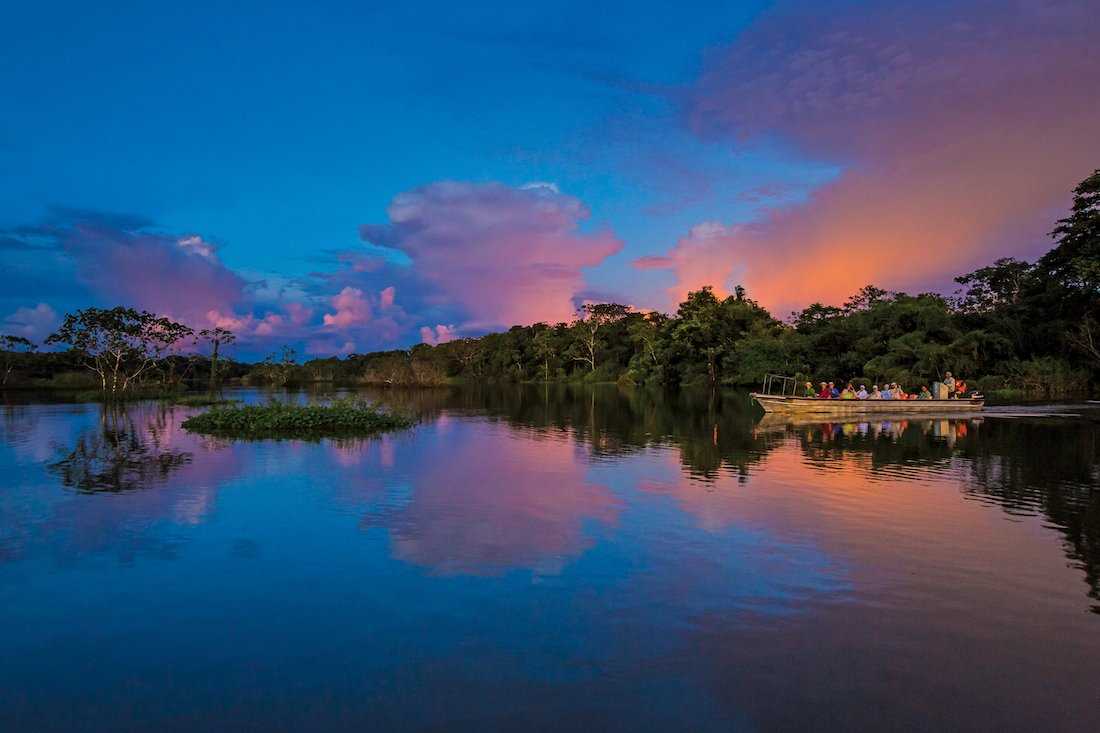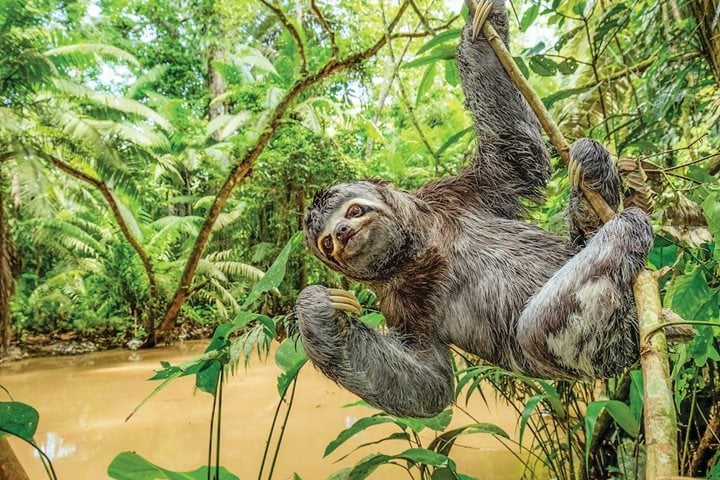Glide through intricate waterways in the upper reaches of the world’s longest river, where pink dolphins frolic and lily pads grow larger than humans. Hike into an emerald rainforest where monkeys jockey for fruit from trees with names like aguaje and camu camu. This is the Pacaya-Samiria National Reserve, which at 5 million acres is one of the planet’s largest wetland ecosystems.
The Amazon, the “King of All Rivers,” supports the world’s most biodiverse rainforest. All life along it adapts to its seasonal fluctuations. What are these river fluctuations in this seasonally flooded forest, and when should you go?
When is the Best Time to Travel to the Amazon?
In the Amazon, temperatures and humidity levels do not change much over the course of a year but the amount of rainfall and, especially, the height of the river do. The Amazon rainforest is lush and green because of the abundance of rain it receives (12 feet on average per year). Although this part of Peru sees about 200 rainy days a year, the weather does not interfere with activities.
The Amazon has two seasons: high water and low water, with very little difference in terms of wildlife seen between the two. Due to snowmelt in the high Andes, water levels rise from December to late May. Every river, creek, and lake is navigable and the forest is often flooded, leaving very few areas to walk and hike in the jungle. In the low water season, late June to November, more trails and jungle paths are accessible, but smaller rivers and tributaries are not reachable by skiff.
Our itineraries are flexible and our expedition teams are experienced with the vagaries of this enchanting rainforest. We lead voyages of discovery in the Pacaya-Samiria year round, working around the rain showers that support the Amazon’s incredible biodiversity, and using our deep local knowledge to optimize wildlife sightings no matter the month. There are, however, differences in the expedition experience in high and low water seasons.
High Water Season (December to May)
In the high-water season, the average daytime temperature is 86 degrees Fahrenheit and drops to 60-75 degrees in the evening.
The geological rise of the Andes Mountains left a depression with soft soil. When the mountain run off from melting snow combines with rainfall that can reach 10 inches in a month, the forest floor becomes flooded. The Amazon then spills into newly formed networks of small rivers, creeks, tributaries, and inlets that are ours to explore; and in the true spirit of exploration, they are never exactly the same. This is one of the last, largest roadless areas on Earth.
Traveling in custom-made skiffs or kayaks, we enter these new waterways, able to deeply penetrate the forest. In the high water season, the forest flowers and produces fruit so we can observe monkeys, birds, and other wildlife drawn by a seasonal abundance of food. In addition, the forest canopy is closer to us in the wet season as water levels can be more than 30 feet higher than in drier months.
Rich in nutrients, the flood waters of the Amazon are dark and reflect the surrounding forest, dubbed the "Mirrored Forest" or "Jungle of Mirrors."
This legendary river holds one-fifth of the planet’s fresh water, and when it covers the forest floor, terrestrial animals need to move to higher ground. Some aquatic wildlife thrives with an increase in food sources like vegetative matter and small organisms. Others like dolphins and otter that feed on fish have a harder time finding their prey in their expanded habitat, and they're not as predictably encountered due to a wider area of habitation.
Low Water Season (Late June to November)
During this time of year, precipitation over the Pacific slows with a marked decrease in rainfall in the Eastern Andes, resulting in a dramatic drop in water levels: the low water season. Temperatures average five degrees warmer than in the high water season.
Because fish have fewer waterways to inhabit in the low water season, they tend to flow into the rivers. Now, larger fish predators like dolphins don’t need to disburse to hunt for food. Opportunities to spot river otters, manatees, caiman, anaconda, and arapaima also increase in the low water season as aquatic animals are more concentrated in the larger waterways where they're following their prey. Also in this season, migratory birds can be observed in addition to the reserve’s more than 500 resident bird species such as scarlet macaws.
With receding water levels, sandy banks appear at the forest’s edge, bringing increased activity. As we travel along the Amazon, terrestrial animals emerge to drink from the river and aquatic birds like the Jabiru stork fish along the banks and also in small lagoons filled with pooled fish that we explore. If we’re lucky, we might come upon aquatic turtles that dig nests in the sandy riverbanks. Also, human Amazon residents use the dry season to grow crops like rice and beans.
Another difference between the seasons is that as new trails and jungle paths appear due to lower water levels, the opportunities to hike into the rainforest increase. At this time, it is more likely to see animals that inhabit the forest floor like collared peccaries and tapirs.
Remember though that wildlife spotting is not limited to the forest and the water! Throughout the year, Pacaya-Samiria’s jaw-dropping birds can be spotted flying overhead as reported by one of our naturalists/certified photo instructors' Aaron Raymond: “On the way back to the ship we stopped at a small island and had a moment of silence to enjoy the sound of tens of thousands of canary winged parakeets flying across the water to roost.”
There is no wrong time for an Amazon adventure—whichever season you choose, you are sure to share this very special wild world with Earth’s most spectacular creatures.




